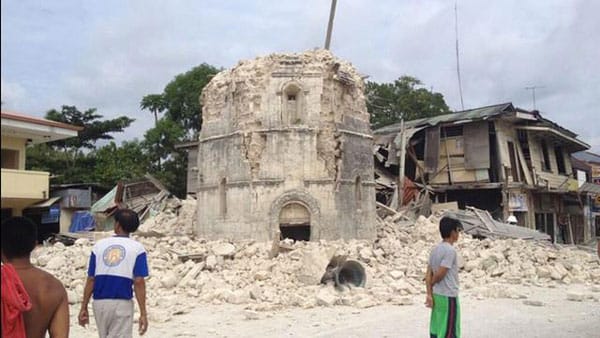On 15 October, at 8:12 in the morning, a major earthquake measuring 7.2 on the Richter scale shook the central Visayan islands in the Philippines. According to experts, it packed the power equivalent to 32 Hiroshima atomic bombs.
The epicenter was located 33 kilometers below the town of Carmen, the tourist town that features the Chocolate Hills, in the center of Bohol island. Casualties have surpassed a hundred and the effects to infrastructure, buildings and property had been devastating. It is estimated that some 400,000 families, in Bohol alone, have been affected.
From the outset, the Order of Augustinian Recollects has felt the catastrophe as its very own. The prior general, Fr. Miguel Miro, sent a message of solidarity to the prior provincial of the Philippines, placing in his disposition the resources of the Order. The Philippine prior provincial himself, Fr. Lauro Larlar, has called on all the communities, parishioners and constituents to pray for the victims and give donations, tasking the Commission of Social and Ecological Concerns to coordinate efforts.
Ruined Recoleto churches
 The church of Loboc after the earthquake After an initial period of alarm and confusion, the National Conservation Socety of the Philippines published a report that enumerated the places that suffered the greatest destruction: “The earthquake – it said – has destroyed important landmarks of our patrimony in Bohol as well as in Cebu and it has totally destroyed or seriously damaged the churches of Baclayon, Dauis, Dimiao, Loay, Loboc, Loon y Maribojoc, in Bohol, all of them listed as National Historical Treasures or Historical Landmarks.
The church of Loboc after the earthquake After an initial period of alarm and confusion, the National Conservation Socety of the Philippines published a report that enumerated the places that suffered the greatest destruction: “The earthquake – it said – has destroyed important landmarks of our patrimony in Bohol as well as in Cebu and it has totally destroyed or seriously damaged the churches of Baclayon, Dauis, Dimiao, Loay, Loboc, Loon y Maribojoc, in Bohol, all of them listed as National Historical Treasures or Historical Landmarks.
We have to underscore that all the churches mentioned in the HCS report were constructed or completed by the Augustinian Recollects, whose history underwent in Bohol island a golden epoch from 1768 to 1885, stretching up till 1936. One then understands why the various Augustinian Recollect communications have expressed the awareness that “the people and places affected by the calamity are very close to the heart of the Augustinian Recollects of the past and the present”.
Loon, Baclayon, Loboc, Maribojoc
 The poster of the campaign in favour of Bohol It is not surprising why all these churches are in the list of cultural treasures of the Philippines. They are all huge and imposing buildings, made of coral stone; church-fortresses, with separate – and equally fortified – belfries that served as watchtowers to monitor the seas, on the lookout for raids by Muslim pirates.
The poster of the campaign in favour of Bohol It is not surprising why all these churches are in the list of cultural treasures of the Philippines. They are all huge and imposing buildings, made of coral stone; church-fortresses, with separate – and equally fortified – belfries that served as watchtowers to monitor the seas, on the lookout for raids by Muslim pirates.
The best example is the church of Loon, considered as “the apex of Recollect architecture”. Located on top of a promontory, it formed part of a whole defensive complex from which only 212 stone steps, twelve meters in width, have remained for posterity. Like other temples and constructions of the past, it was the fruit of the enthusiastic collaboration of the whole populace, under the direction of their parish priest, Fr. Jose Garcia, who finished the project in only seven years (1855-1862). What was a splendid architectural gem, 67 m. long, 28 m. wide and 11 m. high, with a very elegant façade, two bell towers, beautifully decorated vaults, several retablos and the biggest pipe organ in all Bohol, is now just a pile of rubble.
In Baclayon, the tremor was less destructive. The church, constructed in 1727 and considered the oldest in the island, still stands. But the principal elements added by the Recollects in the last third of the 19th century, the portico and the tower, have fallen. The latter had proudly featured, on its massive walls, the seal of the Order and the star of Saint Nicholas of Tolentine; everything has now crumbled.
The same thing happened in the church of Loboc, where the Recollect-built tower and portico has fallen. And, like in Loon, what used to be the ample temples of Dauis (1879), Dimiao (1800), Loay (1838) and Maribojoc (1852), all of them located in the southwest coast of the island, are now a heap of ruins. Additionally, along with the churches, many civic works – roads, bridges, cemeteries, municipal buildings – with which the Recollects of the past have endowed the towns, have either been damaged or destroyed.
Twenty three years ago, an earlier earthquake devastated the south of Bohol. The 1990 tremor seriously damaged the churches of several towns like Jagna, Duero or Guindulman. Nature, it seems, feeds on the building patrimony of the Augustinian Recollects, although they are clear that it is people who are important. It was for the people that those temples and constructions were built, and it is for people’s benefit that the present Augustinian Recollects are now directing their present efforts to help.


